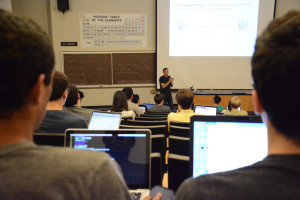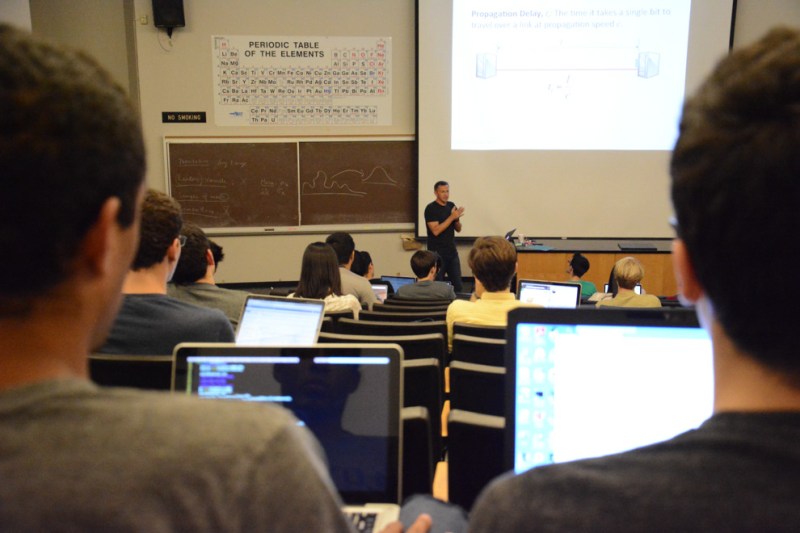
It has been several years since professors first started implementing the “flipped” class model at Stanford — a teaching strategy where the basic material for a course is presented outside of class, often through videos that students can watch at their own pace, and time in the classroom is spent deepening students’ understanding of the subject through exercises, projects and guest speakers.
Though new Stanford classes continue to adopt the “flipped” model every year, many teachers who have experience with this model have now settled on a hybrid between flipped and traditional methods as the most effective learning experience for their students.
Associate professor of electrical engineering and computer science Philip Levis and professor of electrical engineering and computer science Nick McKeown, early adopters of the flipped class model at Stanford, described a process of experimentation and revision as they learned how to most effectively implement the new teaching style.
Levis and McKeown have taught CS 144: “Introduction to Computer Networking” as a flipped class since the fall of 2012. After some students expressed a strong desire for in-class explanations, they balanced flipped components with more traditional lectures.
Now, students are required to attend class on Tuesdays, which are devoted to exercises and guest speakers, while Thursday classes are optional, traditional lectures that review concepts from the online materials. Many students find the videos sufficient and opt out, Levis said, with the added bonus of making the live lecture more intimate.
“I absolutely think that moving to the flipped classroom has resulted in students retaining much more knowledge and having a deeper understanding of networking when they complete the class,” Levis said.
Levis commented that his students are more consistently engaged now.
“Suddenly, they’re not just cramming before the midterm,” Levis said.
While some teachers have fine-tuned their implementations of flipped courses, others are still experimenting.
Materials science and engineering professor Bruce Clemens also flipped his course EE 293A: “Solar Cells, Fuel Cells and Batteries” in 2012, hoping to better accommodate students of varying knowledge levels and to emphasize actual problem-solving in class. However, he switched back to the traditional teaching method last year.
“We didn’t do it as well as we should have,” Clemens said. “The problem that we had was that people didn’t watch the lectures. So they’d come to these problem sessions, and they weren’t prepared, so they wasted a lot of time figuring out how to work the problem. There was some resentment among people who did do the background work – to have to nurse along people who hadn’t prepared.”
The classroom itself, a stadium-seating lecture hall, also made group work physically difficult.
Clemens said these issues can be fixed and that he may try to implement a hybrid course with both flipped and traditional elements next year. Class would still involve problem-solving sessions, but he would offer students an option of either watching videos or reading about the material.
Clemens also spoke of creating more incentives for students to watch the videos or do the readings, such as associated homework exercises or a forum where students must comment about the material.
Citing an MIT study that suggested students’ brains are much less active during lecture than during labs or while doing homework, Clemens said that he is very interested in improving education with new learning formats.
“I’ve been teaching here at Stanford for a long time, and I’ve sort of become disillusioned with lecturing as an efficient way to teach people,” he said.
Stanford supports this desire for new methods in part through the Vice Provost for Teaching and Learning’s (VPTL) Digital Learning Design Team, which offers consultations, an academic technology lab and grants to fund teachers’ digital learning proposals. Twenty-five grants were awarded last school year, and 39 were awarded the year before.
“It always starts with the teacher interest,” said Andrew Saltarelli, Stanford director for digital learning and design. “We’re here to collaborate with them.”
Saltarelli said that it is difficult to count how many flipped classes are at Stanford because the flipped concept has taken such different forms in different classes.
For example, MATH 51: “Linear Algebra and Differential Calculus of Several Variables” uses “active learning,” a modification of the flipped format where students read lessons and answer questions before coming to class, but class time still involves explanation by the teacher.
MATH 51 has greatly expanded its flipped component this year after encouraging results from previous active learning-style sections, including two last spring. Students in the active learning sections did better on exams than their traditional section peers, said Mark Lucianovic, a senior lecturer for the course.
This year, five out of six lecture sections use the active learning format, and about three-quarters of the 335 students currently enrolled in MATH 51 or 51A are in active learning discussion sections, according to Lucianovic.
By coming prepared, students can engage more actively in lecture, Lucianovic said.
“I go into lecture, and I basically know everything that [Lucianovic] is going to teach,” said MATH 51 student Nicolas Pena ’19. “But I still feel the need to read it early because when we go through it together in class a final time, I feel like I know the material way better than I would otherwise.”
Contact Hannah Knowles at hknowles ‘at’ stanford.edu.
